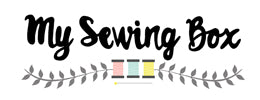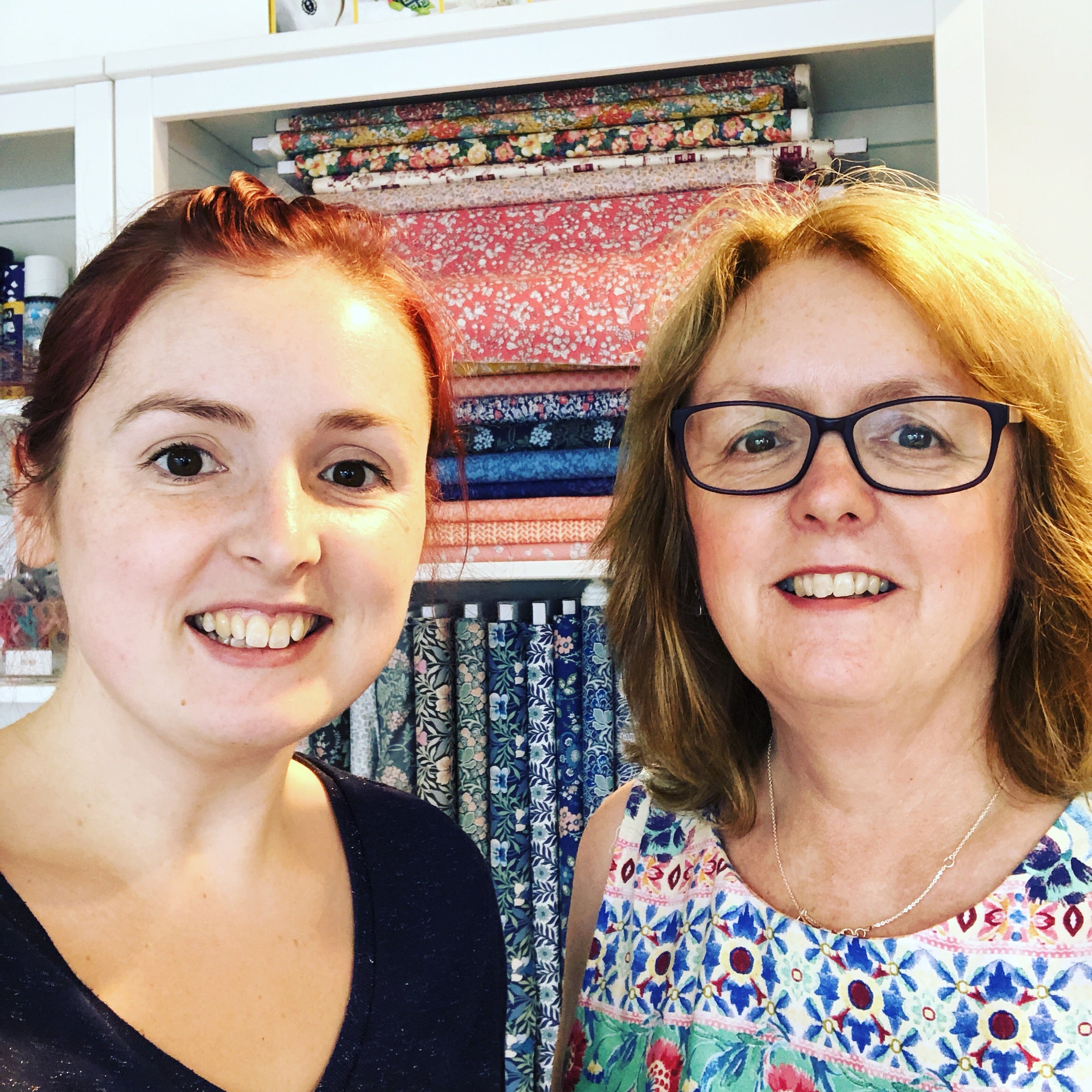Always wanted to give sewing a go but didn't know where to start? We've compiled an easy place to give you all the information you need to get started in this creative hobby!
In this blog post, we give you a brief idea of what most of the common fabric types are like...
Sewing for Beginner's: Guide to Materials
One of the biggest learning curves when sewing is learning what different types and weights of fabric are!
Fabric comes in different weights or thicknesses, which are referred to as light, medium, heavy etc, and can also be referred to more accurately by their "gsm" (grams per square metre). The thicker the fabric, the heavier the weight and the higher the gsm number. Fabrics like cotton poplin and lawn are considered light weight and usually have a gsm of around 100; heavy fabrics like denim are more likely to have a gsm over 250. The gsm can also be an indicator of quality if you are buying online.
Here are some of the most common types of fabric:
Cotton Poplin - a light weight cotton that feels smooth to the touch and has a very small amount of drape. Good for lots of projects including summer dresses and skirts, lightweight trousers, tops, quilts and accessories like make up bags. It also makes a great breathable lining for clothing and bags.
Cotton Lawn - a light weight cotton, but with a slightly rougher feel to the surface and a more open weave. They tend to be even lighter than poplins, but are very breathable and comfortable and can be used as above.
Quilting Cotton - this is a medium weight cotton with a reasonable amount of structure so it's great for patchwork, quilting, bags and accessories, as well as semi-structured clothes that don't need drape. They're extremely easy to sew with due to their weight and lack of movement!
Viscose/Rayon - a light weight drapey fabric that's ideal for garments that want a lovely drape and hang to them like skirts, dresses, trousers and tops. It has a smooth, slightly silky texture and is made from a natural cellulose fibre. It can be a bit more slippery to work with for a beginner, and also tends to fray a bit more on the cut edges. Due to it's natural fibres, it's a popular choice for summer clothes as it's very breathable and cool.
Satin - a silky fabric with a classic sheen/shine to the surface, it can come in different weights from stiffer and heavier duchess satin, to lighter weight and more drapey silky or micro satin. Great for occasion and evening wear.
Sateen - usually a cotton type fabric with a matte sheen on the surface, that's often got a touch of stretch and is best used on smart fitted garments like structured dresses, work wear, trousers and skirts. It doesn't usually have much give so it's great for creating structured, tailored shapes.
Silk - a high quality, breathable fibre that can be any weight. Usually it's made into other types of fabric like silk chiffon, silk georgette etc. It can be harder to work with usually because it makes your fabric finer and more slippery. It's quite expensive so it's usually only used on occasionwear.
Coating - a thicker, woolly type fabric with a soft touch - like you'd normally see your shop-bought coats made from. It's ideal for... coats! It doesn't usually have any stretch and is very heavy weight.
Wool - often in thicker weights though you can get lighter wool fabrics for making skirts etc. Most wools are ideal for fitted garments like jackets as when pressed they hold structure well and are warm and dry.
Lace - a highly decorative woven fabrics with a wide open weave. It comes in different weights and can be stretch or non-stretch. You will normally need to use a lining underneath it for most garments.
Flannel/Brushed Cotton - this is cotton with a soft texture to the surface. It's often used for pyjamas and lounge wear as it's so comfy and cosy, though you can also use it on quilts, especially for baby and children's ones.
Polycotton - a cotton and polyester mix, it's often the cheapest type of fabric you can buy and is great for low cost fabric and practicing. It's not recommended so much for clothing as it can be a bit sweaty due to the polyester, especially for those prone to sweating or with sensitive skin!
Chiffon - a very light weight, see through fabric that's often used for the outer layer of skirts. It has a lovely flow to it and can add volume. It's also notoriously a pain in the bum to sew with as it's so light and can move a lot, so it needs plenty of pinning!
Georgette - a light to medium weight, translucent fabric; think of a heavier version of chiffon that's less see-through. Again, it's often used on occasion dresses as an overskirt with lining underneath. It's got a lovely drape to it too.
Crepe - crepe is georgette's heavier cousin. It still has the lovely drape but tends not to need lining if it's good quality and comes in many lovely printed designs.
Peachskin - this is a woven polyester fabric that has a slightly fuzzy soft texture to its surface, like a peach! It has a bit of drape so it's a great alternative to viscose for a beginner looking for a fabric with drape that's easier to work with.
Corduroy - a medium to heavier weight fabric with a velvety texture and lined surface. It can have a small amount of stretch for comfort, or no stretch. Commonly used for hardwearing garments like trousers, skirts, dungarees.
Denim - a dense woven fabric that's hardwearing for items like jeans, skirts and dresses as well as bags and accessories. It can be stretch or non-stretch and come in different weights depending on how heavy you want it - heavier types tend to be used for jackets and bags.
Chambray - this is a light weight denim type made from cotton or a mix of cotton and other fibres like viscose or polyester, and has a very small amount of drape. It's great for lighter and airier items like shirts, shirt dresses, tops and skirts.
Linen - a medium to heavy weight woven fabric, pure linen has a lovely weight and hang to it for structured dresses and trousers. Linen mixed with fibres like viscose or cotton make it lighter; viscose linens have more of a drape and a slightly lighter weight which makes them fantastic for summer garments like dresses, trousers, skirts and shorts. Linen is a natural breathable fibre, so great for those with sensitive skin and for hot weather, but it does tend to crease easily - go for a linen blend if you want to minimise creasing.
Velvet - a soft, short pile fuzzy-textured fabric that's usually used for evening wear like dresses and skirts. It can be stretch or non-stretch, and either have a matte, glass-like or "crushed" finish. If you brush it one way, it will look different to when you brush it the other way so be mindful of this when cutting out!
Jersey - a stretch fabric in light to medium weights that's a great all-rounder for things like tops, t-shirts, leggings and dresses. Cotton jerseys are easier to work with and a bit thicker; viscose jerseys have more drape and are thinner but can be more slippery to work with.
Ponte Roma - a thicker stretch fabric, with a slightly satinised texture. It's low-stretch so easier to work with and makes great skirts, dresses and stretch garments that want a bit more structure and bit of a smarter look.
Interlock/double knit - this is usually a thicker, medium weight fabric that's got a matte texture and is a bit thicker than jersey. Great for dresses, hoodies, tops etc.
Sweatshirting - a thick, low-stretch fabric that's warm and cosy, ideal for sweaters, hoodies and jogging bottoms. It normally has a smoother side with a plain or printed design, and the back is fluffier and cosier with a brushed finish.
Ribbed/sweater knit - this is a stretch fabric that has a lined, knitted texture to it and is often warm and thick. It's ideal for winter wear like jumpers and dresses.
Ribbing/cuffing - this is usually used in conjunction with jersey or sweatshirting, and is a thicker, heavier ribbed fabric designed to withstand the extra wear and tear your garments may get on the cuffs and waistband. It's usually sold on a much smaller width roll but half a metre will go a long way - you usually only use it on cuffs, waistbands and sometimes neckbands.
Suiting - this can come in stretch or non-stretch varieties and is usually made from fibres like cotton, polyester, nylon etc. It's good for smart items like structured skirts, trousers and jackets.
Plush/fur - a low-pile fur-type fabric that is super soft to the touch, like animal fur. It's a popular choice for children's blankets, teddies, toys and dressing gowns.
Leather - either genuine made from animal hide, or more common faux leather made from man-made fibres, it has a heavy weight while often still being quite supple and soft to the touch. A good quality faux leather can be used for bags and accessories, as well as structured garments like skirts or dresses.
Suede - real or faux, it has a peached sort of texture to it and is often semi-structured. Use for bags, accessories and upholstery as well as garments like skirts or dresses.
Canvas - a heavy weight, densely woven cotton or polyester type fabric. It's hardwearing and most commonly used for bag making, home accessories and upholstery, although you can use it for more durable garments like skirts.
PVC/Oilcloth - a laminated fabric that usually has a cotton base that has been laquered over with a waterproof polyethene type finish. They are wipe clean and waterproof usually, but can stick to your machine as you sew - use a teflon foot or tissue paper to help prevent this. Great for tablecloths, bags and cosmetic bags - anything you want to wipe clean!
Tweed - a heavy woven fabric with a traditional woven pattern, that's great for skirts, jackets and also bags. It can fray quite a lot so you'll want to overlock or bind your seams, and you will need a lining if you are making a garment.
Jacquard - a fabric with the design woven into the fabric as opposed to printed on the surface. Can come in stretch or non-stretch varieties and is usually medium to heavy weight.
Interfacing - this is not a fabric as such, but does also come in different weights, and is used alongside your main fabric to stabilise and reinforce areas of your sewing. You can get iron-on or sew-in varieties, though most modern patterns will suggest using fusible or iron-on versions. Choose a weight that is similar to your fabric, eg lightweight interfacing for a lightweight fabric like cotton poplin or viscose.

